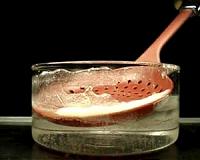 |
Washington (AFP) July 19, 2010 None of the anomalies detected close to BP's blown-out well in the Gulf of Mexico are threatening the integrity of the capped wellhead, a senior US official said Monday. Seepage found some three miles (1.9 kilometers) from the capped well was not related to the operation to staunch the flow of oil from the wellhead, said US Coast Guard admiral Thad Allen. "We do not believe that is associated with this particular well integrity test," Allen, the US pointman in charge of the government's response to the disaster, told reporters. "At this point there is not any reason to believe that we have anything that's a major issue in relation to the well's integrity from the seepages we've located." Days of testing by BP and the government since the cap was closed off had picked up other "anomalies" a few hundred meters (yards) from the well, and showed there was "some leakage in the capping stack" atop the well head. But Allen stressed "we do not believe this is consequential at this time." BP wants to keep the valves on its containment cap closed continuously until an operation to permanently seal the well can be performed in less than two weeks time, meaning no more toxic crude would stream into the Gulf. But the government is granting extensions only in 24-hour increments and has ordered the British energy giant to be ready to remove the cap immediately if the seepage is confirmed to be methane. Measuring devices on BP's cap have given steadily increasing high-pressure readings since tests began Thursday, indicating there are no major leaks in the wellbore. "The pressure sits at 6,811 pounds per square inch and continues to gradually rise several pounds or a pound or so every hour. And that's a positive trend," Allen said.
earlier related report The US government earlier authorized BP to keep the busted well shut in for another 24 hours despite the mysterious seepage and other anomalies that could indicate the wellbore below the seabed is damaged and leaking. White House spokesman Robert Gibbs did not elaborate on the "seepage," but confirmed that gas bubbles had also been detected by underwater cameras around the actual wellhead. "There is seepage about three kilometers away from the wellhead. There are bubbles that are visible on the underwater camera, which we continue to monitor. "And there are some leaks from the upper part of the wellhead," Gibbs said, around a device known as a shear ram, which is a part of a blowout preventer which sits on top of an oil well. "Those all bear special monitoring." A vessel belonging to the government's National Oceanic and Atmospheric Administration (NOAA) had also discovered other "anomalies" that needed to be checked out, he added. BP wants to keep the valves on its containment cap closed continuously until an operation to permanently seal the well can be performed in less than two weeks time, meaning no more toxic crude would stream into the Gulf. But the government is granting extensions only in 24-hour increments and has ordered the British energy giant to be ready to remove the cap immediately if the seepage is confirmed to be methane. "We had some concerns, I think as you heard over the past 24 hours, about commitments that BP had made that we did not feel that they were adequately living up to in terms of that monitoring," Gibbs said. "That was dealt with last night on a call that lasted late into the evening, where we believe that we're getting the type of overall monitoring, particularly the seismic and the monitoring with remotely operated vehicles, so that we can look at each of these different steps." Measuring devices on BP's cap have given steadily increasing high-pressure readings since tests began Thursday, indicating there are no major leaks in the wellbore. Seismic and sonar surveys and video footage filmed by robotic submarines in the murky depths of the Gulf have also been monitoring whether any oil or gas was leaking through the rock formations on the sea floor.
Share This Article With Planet Earth
Related Links Powering The World in the 21st Century at Energy-Daily.com
 CCNY-Led Team Develops Non-Toxic Oil Recovery Agent
CCNY-Led Team Develops Non-Toxic Oil Recovery AgentNew York Ny (SPX) Jul 19, 2010 A team of chemists led by Dr. George John, Associate Professor at The City College of New York (CCNY), have developed a non-toxic, recyclable agent that can solidify oil on salt water so that it can be scooped up like the fat that forms on the top of a pot of chilled chicken soup. The agent could potentially be used to recover oil lost in the British Petroleum (BP) spill in the Gulf of Mex ... read more |
|
| The content herein, unless otherwise known to be public domain, are Copyright 1995-2010 - SpaceDaily. AFP and UPI Wire Stories are copyright Agence France-Presse and United Press International. ESA Portal Reports are copyright European Space Agency. All NASA sourced material is public domain. Additional copyrights may apply in whole or part to other bona fide parties. Advertising does not imply endorsement,agreement or approval of any opinions, statements or information provided by SpaceDaily on any Web page published or hosted by SpaceDaily. Privacy Statement |